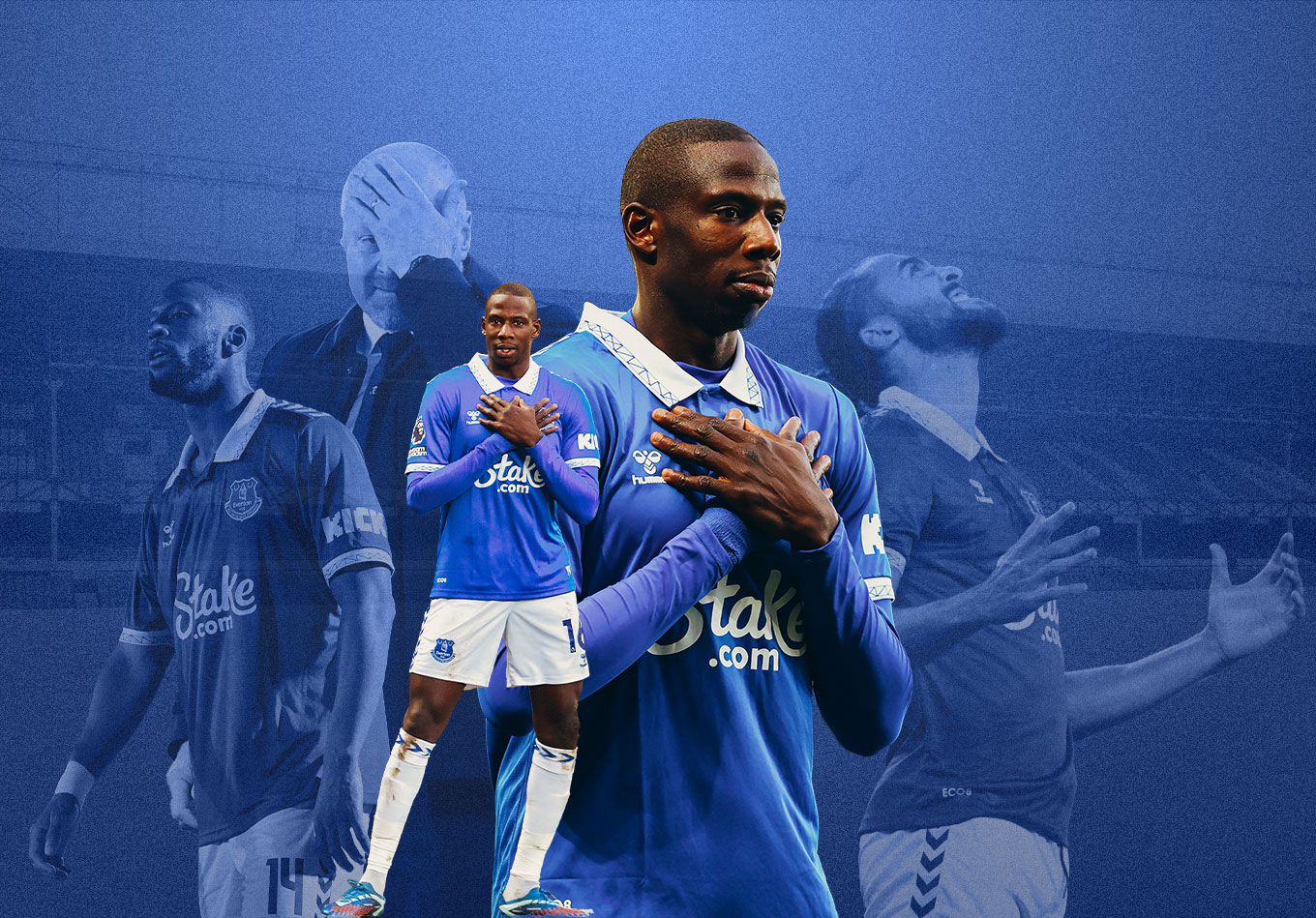Everton are the biggest xG underperformers in Europe’s top five leagues, and that will need to change if they are to stay up.
Sean Dyche has found a way for Everton to be effective. But the frustration was clear at Goodison Park on Monday, as Crystal Palace held on for a 1-1 draw – Jordan Ayew having put the Eagles ahead before substitute Amadou Onana headed home an equaliser from Dwight McNeil’s corner.
Everton are the biggest expected goals (xG) underperformers in Europe’s top five leagues, having scored 27 non-penalty goals in the Premier League from a non-penalty xG of 38.5. Their expected goals on target (xGOT) total is 31.7, suggesting poor finishing has certainly played a part. However, there is also a feeling that Dyche’s style of play perhaps limits what kind of opportunities they can create.
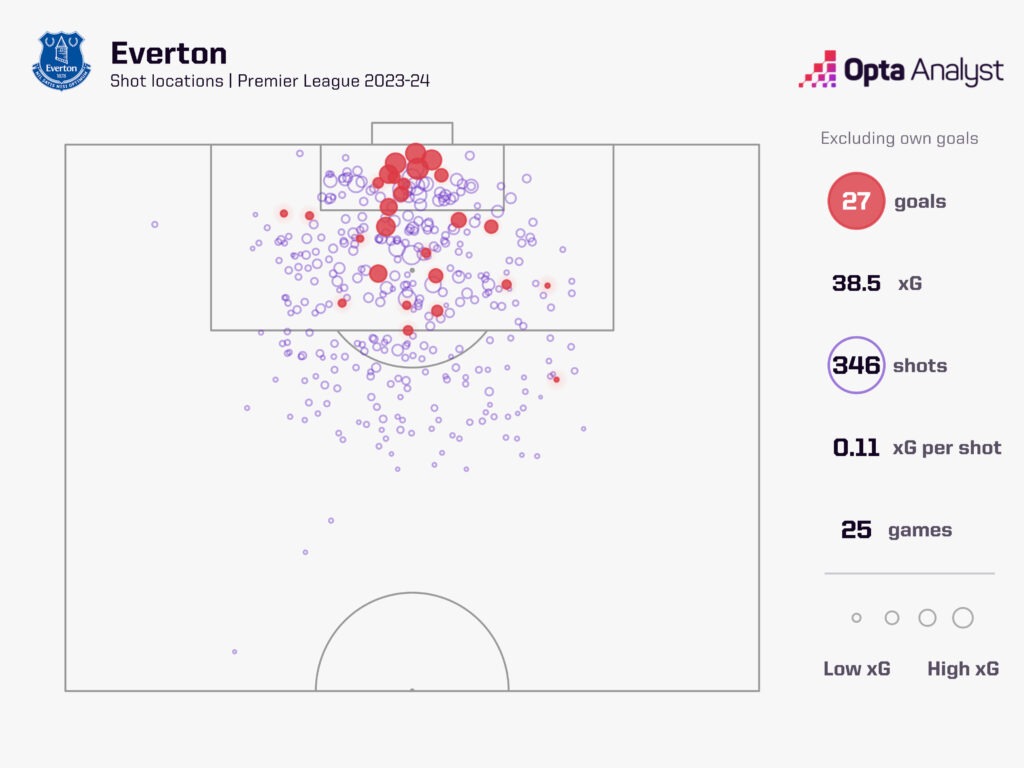
As might be anticipated from a Dyche team, Everton are excellent from set-pieces, yet from open play – and in particular in home matches (they have won just three Premier League matches at Goodison Park this season) against teams that are happier to hand Everton the majority of the possession – the Toffees, who have not won in the top flight since mid-December, often come unstuck.
Abdoulaye Doucouré’s absence has not helped, and having the midfielder back in the fold will be crucial in the run-in – as will any points that may or may not return on appeal of Everton’s 10-point deduction that was handed their way in November. Then, of course, there is the lingering threat of another possible deduction for a second charge relating to alleged breaches of Profit and Sustainability Rules.
On Saturday, Everton head to the Amex Stadium to face Brighton & Hove Albion. The corresponding fixture last term is not just the standout performance of Dyche’s tenure, but the standout performance of what has been a miserable few years for the Merseyside club. Doucouré scored twice, McNeil was magnificent, Dominic Calvert-Lewin led the line imperiously and Everton beat Roberto De Zerbi’s team 5-1, a result that ultimately paved the way for them to stay up by beating Bournemouth on the final day of the season.
With 13 games remaining and Everton – as it stands – sitting outside of the relegation on goal difference only, Dyche needs to start winning games again. But what can he do to fix Everton’s goalscoring issues?
The Doucouré Dilemma
That 5-1 win at the Amex last season was a true bolt from the blue, though it must be said Dyche has had Everton performing well on the road since he replaced Frank Lampard in January of last year.
Everton have lost just eight league away games under Dyche; twice at Anfield, once at Old Trafford, once at Tottenham Hotspur Stadium, once at Villa Park, once at the Etihad Stadium and once at Molineux. Everton have won five league matches on the road this season; for a team that won just four such games combined over the previous two campaigns, that is no small feat.
That fever dream on the south coast in May started inside the first minute. Doucouré slotted in after just 33 seconds following fantastic work from Calvert-Lewin. He would go on to score again before Jason Steele’s own goal paved the way for McNeil’s second-half double.
As far as counter-attacking displays go, you won’t get much better. Jordan Pickford had to be on form, given Brighton recorded 3.3 xG to Everton’s 2.3, with the Seagulls having 13 shots to their visitors’ 10, but the Toffees showed that clinical edge that has so often been lacking this term, with all of their goals having come from open play.
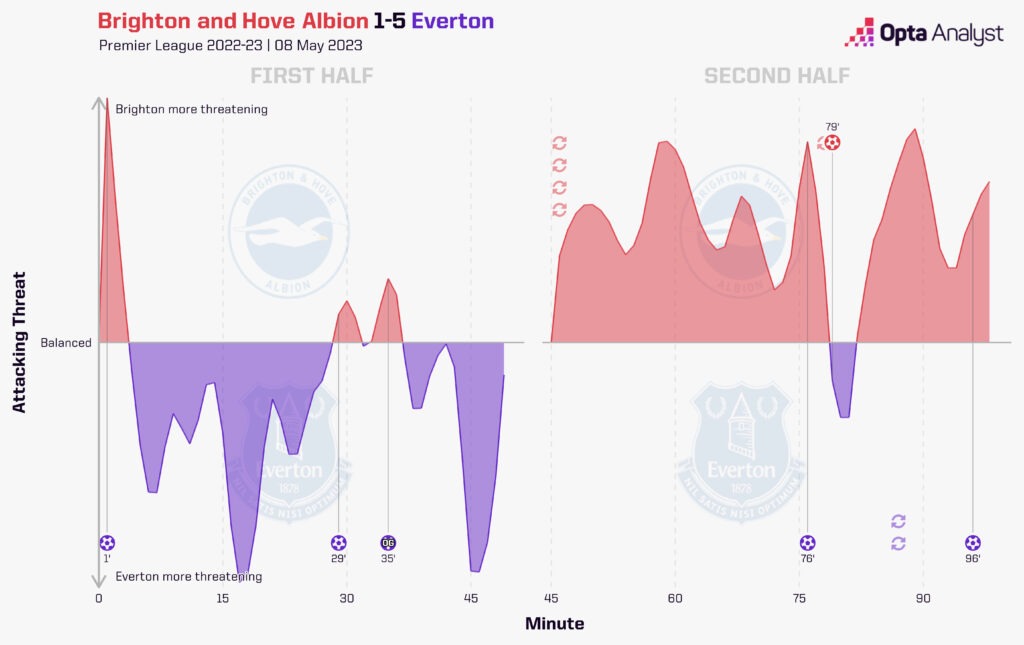
Repeating that display will not be easy, though there’s no doubt a chance this is exactly the kind of game that suits Everton. The onus is not on them to have the ball and they will have space to break into, though De Zerbi will surely have learned his lesson too.
However, the three players – McNeil, Calvert-Lewin and Doucouré – who were pivotal in that attacking display for Everton nine months ago are either badly out of sorts or just returning to fitness.
McNeil provided the assist against Palace but has looked short of fitness and form for weeks. Calvert-Lewin is becoming increasingly isolated up front, and when chances do come his way he is snatching at them; he has scored six goals fewer than would have been anticipated based on the quality of opportunities that have come his way this season, making him the biggest xG underperformer out of all the strikers to have scored at least once in Europe’s top five leagues this term.
Doucouré, meanwhile, managed 75 minutes against Palace in his first appearance since returning from a hamstring problem he suffered at home to Aston Villa on 14 January. Before that, the 31-year-old had been absent since going off injured at half-time against Burnley – the last league game Everton won – a month earlier.
There is no player more crucial to Dyche than Doucouré, who is the team’s leading scorer but is also key to making Everton’s press tick. Indeed, when stacked up against other forwards in Europe’s top five leagues, given he has spent most of the season playing in an advanced role, Doucoure ranks in the 93rd percentile for possession won and the 89th percentile for defensive actions. When compared with midfielders, as seen below, the Mali international is in the 94th percentile for goals and 91st percentile for touches in the opposition box.
Dyche is yet to win a league match in which Doucouré has not featured. Everton average just 0.3 points per game in Doucouré’s absence, compared to 1.4 when he is in the side. They concede more goals (1.9 to 1.3) and score fewer (0.6 to 1.2) per game if he is missing. The difference is stark.
Not that it is solely a Dyche problem. Since Doucouré – who fell out of favour under Lampard but was a key figure for Carlo Ancelotti and Rafael Benítez – made his Everton debut in September 2020, the Toffees have won just three (8.3%) of the 36 league fixtures in which the former Watford man has not featured, compared to a 39.8% win ratio from the 103 games he has played.
And Doucouré also seems set to be crucial to fixing Everton’s open-play attacking issues. In the six matches he has missed this term, the Toffees have managed just 44 shots in open play (7.3 per game), scoring only one open-play goal and accumulating a measly 4.2 open-play xG (0.7 per game). Yet across the 19 matches in which he has featured, they have had 184 open-play shots (9.7 per game), netted 12 open-play goals and tallied up 20.3 open-play xG (1.1 per game).
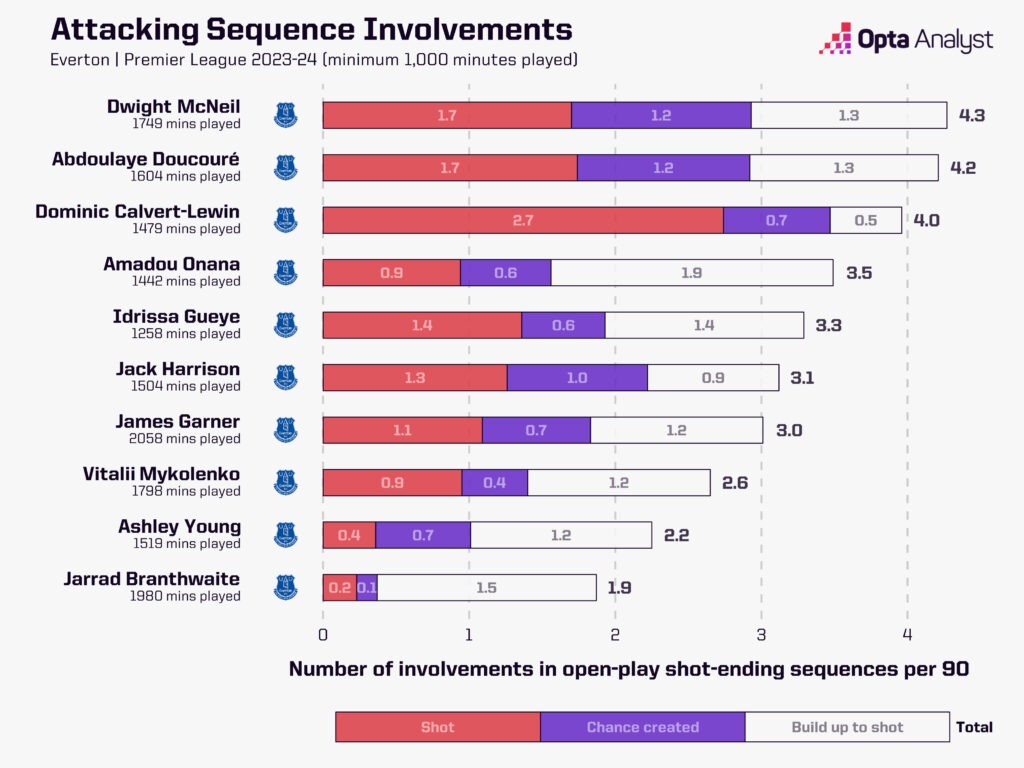
Time for a Plan B?
It is clear how Everton have created their opportunities this season. Of their 27 league goals, 14 of them have come from set-pieces, and 10 of those from corners.
Everton have scored just once from open play since December 23, a run of eight league matches; though they have netted just five times in total across that run. That goal came against Manchester City, with Everton applying pressure in the final third, forcing an error from Rodri, and McNeil teeing up Jack Harrison for a simple finish.
That ability to turn possession over has arguably been Everton’s main source of getting into threatening positions in open play; they lead the Premier League for pressures resulting in a turnover with 861 across their 25 games this term, 62 more than next-best Tottenham. The Toffees are eighth for pressures in the final third resulting in a turnover, with 317.
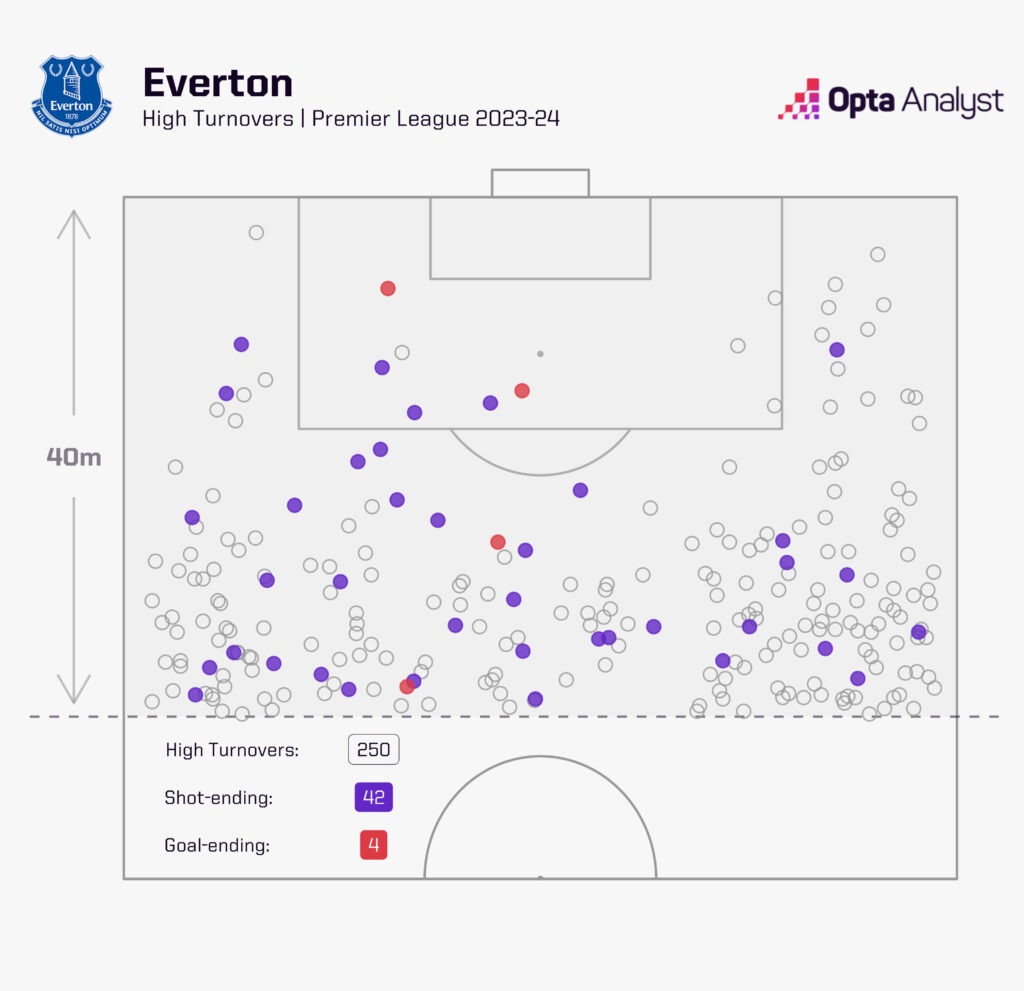
Only Spurs (10.6) have forced more high turnovers per game than Everton (10) in the Premier League this season, with just Arsenal (2.0), Tottenham (1.8) and Manchester United (1.8) having more shots from such situations than Everton (1.7) per game. However, Dyche’s team have only scored four goals from those turnovers, which ties for ninth in the division.
Not that Everton are a pressing machine; they allow 14 opposition passes per defensive action (PPDA), which ranks 13th. They pick and choose their moments, though this has represented a clear evolution from Dyche’s style of play at Burnley.
In Dyche’s final season at Turf Moor, in which he managed 32 league matches, Burnley averaged 7.9 high turnovers per game – 2.1 lower than Everton this season. Dyche is looking to press higher than he did during his last months in charge of the Clarets.
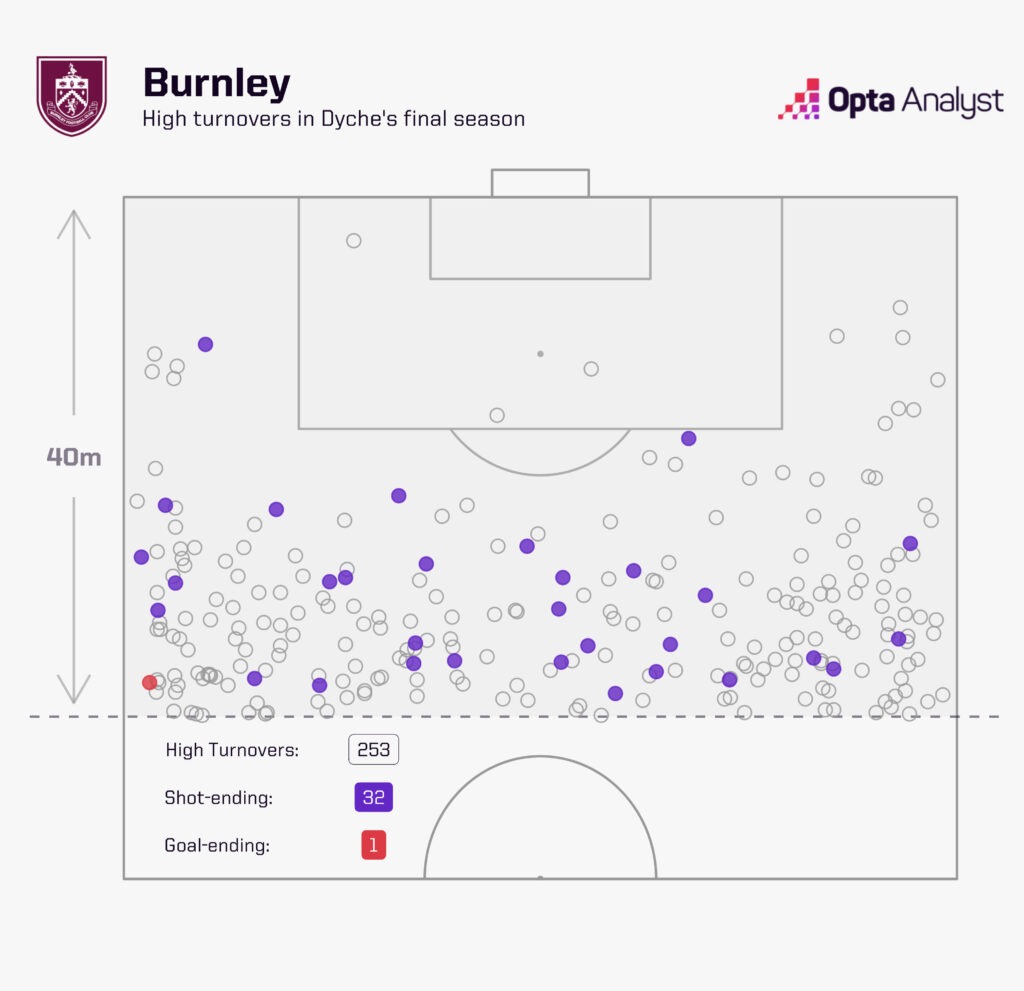
However, what has become increasingly evident is that Everton struggle when the impetus is on them to control the ball and work openings while in possession. They have won only two league matches this season when they have had over 40% possession (3-1 vs Brentford – 42.6%, 3-0 vs Bournemouth – 47.4%). Everton’s average possession figure (38.7%) is the second-lowest in the Premier League, with only Sheffield United (35.6%) seeing less of the ball.
A lack of invention in open play, pressures aside, has been evident, with Everton largely reliant on crossing. They have attempted at least 10 crosses in open play in 19 of their 25 top-flight games. Only Luton Town can match Everton’s tally of 364 open-play crosses, though the Toffees’ crossing accuracy of 20.6% ranks down in 10th.
With Calvert-Lewin and his back-up Beto struggling, scoring just four league goals combined, peppering in crosses is perhaps not the solution to Everton’s scoring issues. Calvert-Lewin won 17 of his 20 aerial duels against Palace, yet often found himself without any teammate in support.
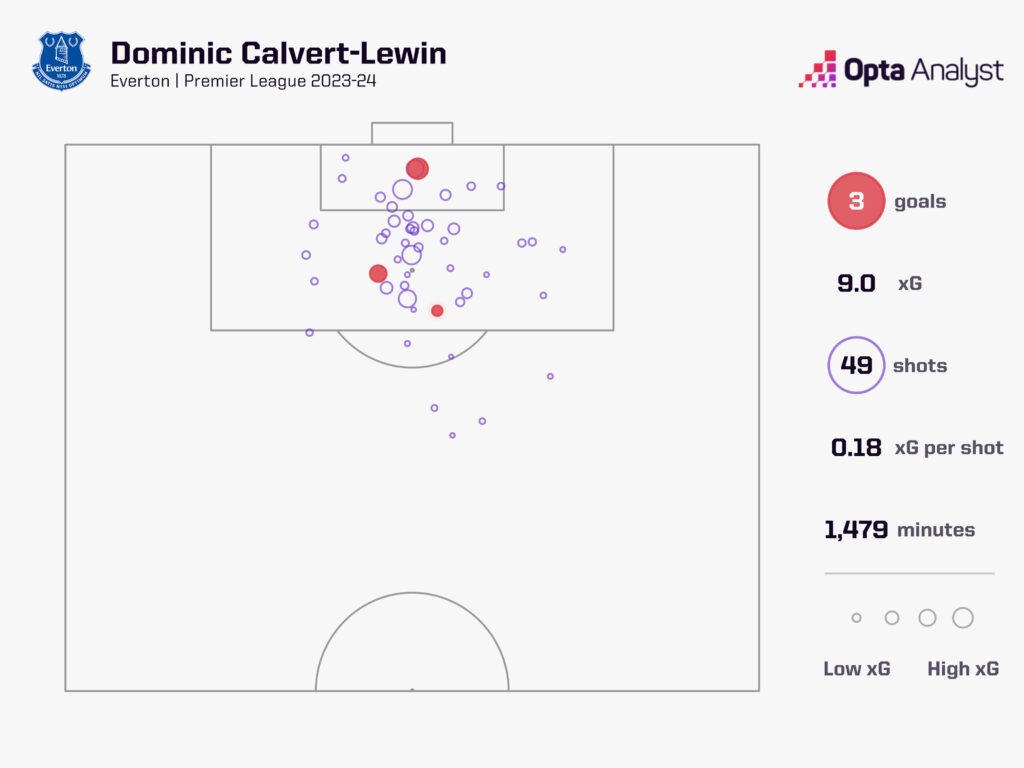
In contrast, Everton are one of the best teams in the Premier League when it comes to set-pieces, though it does feel this is increasingly becoming a crutch for Dyche and the players, whose primary focus seems to be on wining set-pieces – something akin to NFL special teams.
Everton lead the Premier League for non-penalty set-piece xG, with their figure of 14.1 well clear of any other side, while only Arsenal have netted more goals from non-penalty set-pieces (17 to Everton’s 14). The Toffees, meanwhile, also top the league for xG from corners, with 10.4. Again, only Arsenal have scored more goals from corners than Everton (11 to 10).
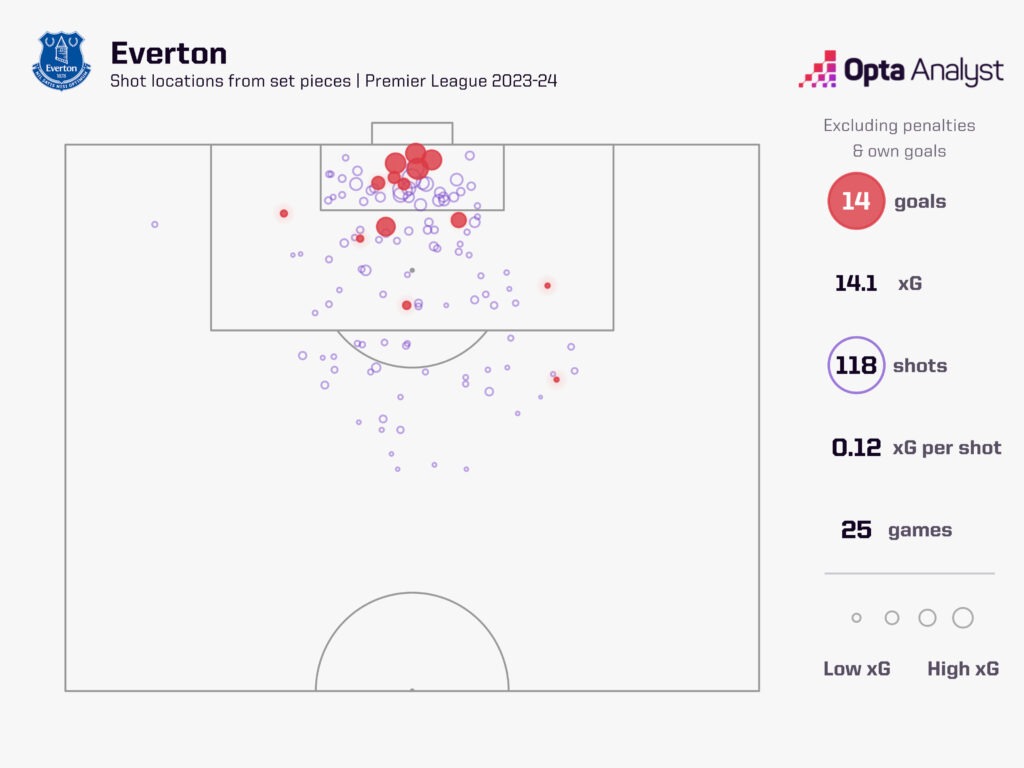
Comparatively, Everton are 13th for open-play xG (24.5), but their 13 goals from open play ranks joint-worst along with Sheffield United. Their -11.5 differential between open-play xG and open-play goals scored is by far the biggest in the league, -4.5 worse than Chelsea’s -7.
Making it Happen
At the start of the season, Dyche often pointed to Everton’s high xG, though in recent weeks he has started urging his players to “make it happen” rather than referring to the statistics alone.
Everton, according to Opta’s expected points model, should be as high as seventh. Not taking into account their deduction, Everton have earned 30 points this term, which should be enough to see them sit 12th. Yet the data suggests that even that would be quite a sizeable underperformance, with the Toffees’ expected points total standing at 38.2. Only Brentford (-10.2) and Burnley (-8.4) have a bigger negative differential between actual points gained and their expected points total according to the Opta model.
Everton’s 38.5 xG may be the 11th-best in the Premier League, but it must be noted that there has been a gradual drop-off from the opening stages of the season when looking at their six-game rolling average. But it’s been alarming how their conversion of those chances has dramatically dropped again following a period of mirroring the quality of shots they created.
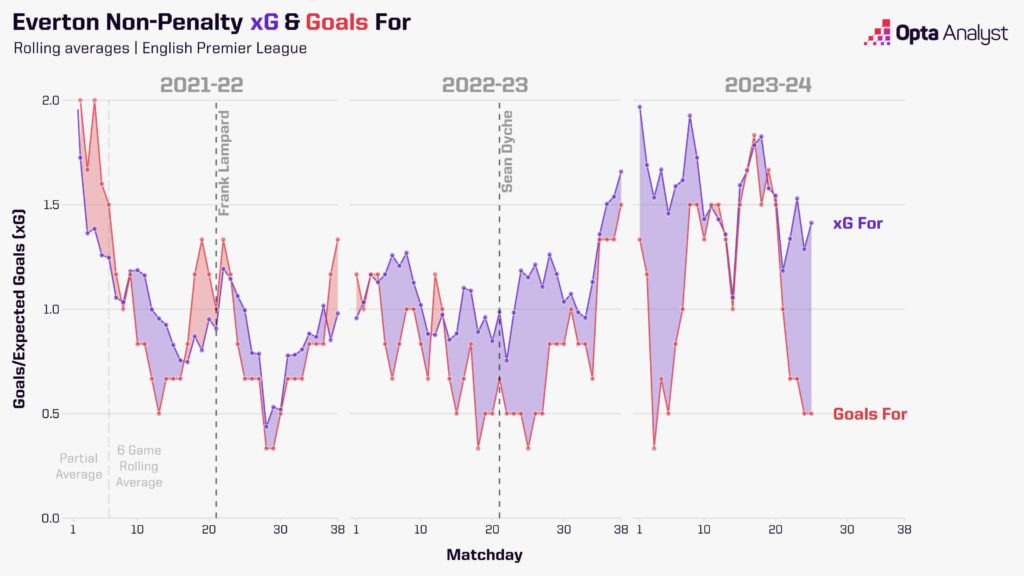
Everton have still managed to find a way to create big chances – opportunities from which a player would reasonably be expected to score. In a 0-0 draw with Fulham on January 30, Everton failed to take all six of the big chances they created; against Palace, they missed three out of four.
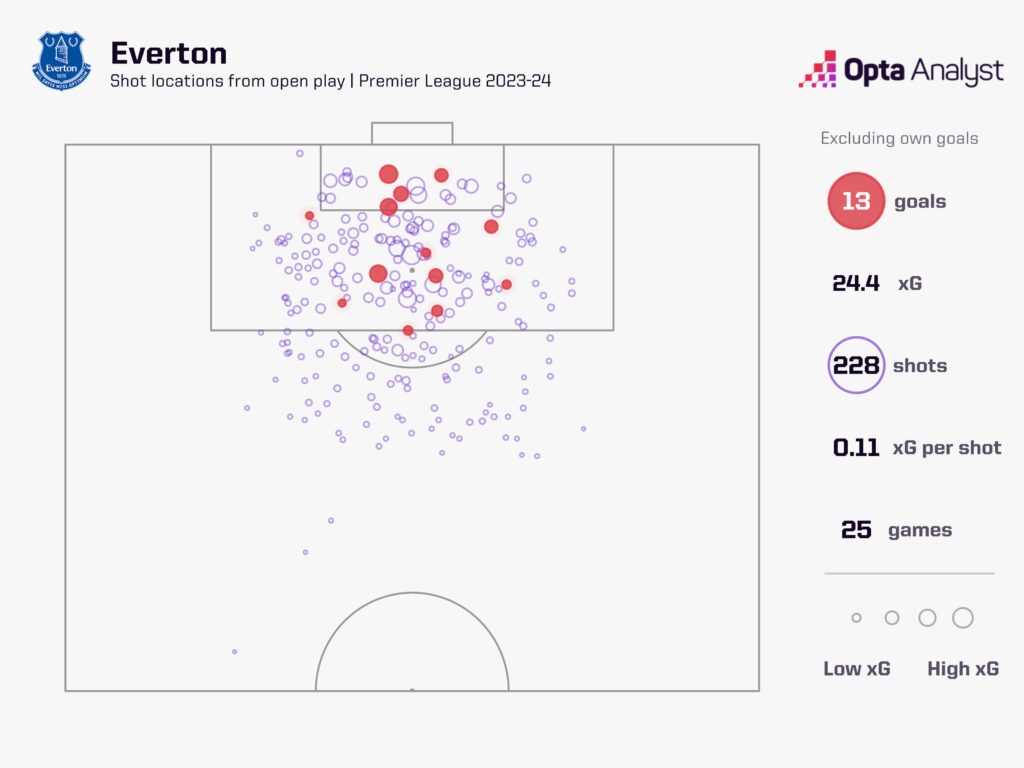
The picture is clearer from open play, however. In the 12 games since the start of December, Everton have mustered a meagre 10.1 xG in open play (0.84 per game), down from 14.4 xG (1.11 per game) in open play across their 13 fixtures before that. The Toffees are becoming ever more reliant on their set-piece expertise, but one can’t shake the feeling they are becoming increasingly one-dimensional.
A word for the defence, however. With Jarrad Branthwaite and James Tarkowski forming an excellent partnership, Dyche has built a team that is one of the toughest to break down in the league.
Everton rank fourth for xG against (34.4), behind only Liverpool (31.3), Manchester City (23.9) and Arsenal (18.3). Considering they finished last season second-worst in the Premier League for this metric (66.1), the scale of the job Dyche and his coaching staff have done in improving the backline must be lauded.
The hope will now be that with a tough run of fixtures out of the way, Everton can progress back towards the mean in terms of finishing. However, four of their next six fixtures come against teams that rank in the top 30 of the Opta Power Rankings in Liverpool, Manchester United, Brighton and Newcastle United, although the Merseyside derby could well be rearranged. Everton, for reference, are ranked 51st.
The foundations are in place for Dyche. Poor finishing has certainly been a huge issue, that much is clear, with only Sheffield United registering a worse big-chance conversion rate (25%) than Everton’s 28.8% (19/66), but this has now been the case all season long. So too, has misfortune and some contentious refereeing decisions – the Toffees, for example, are yet to be awarded a penalty this season. Lorient are the only other team in the top five European leagues to not have won a spot-kick in 2023-24.
Ultimately, it is Dyche’s job to find a way – that may mean becoming more adaptable and flexible in his approach, specifically at home. Points may or may not return on appeal, and while his team may be a mid-table side should that deduction not have occurred, in reality they are set for another relegation scrap unless things change quickly.
Enjoy this? Subscribe to our new football newsletter to receive exclusive weekly content. You should also follow our social accounts over on X, Instagram, TikTok and Facebook.
